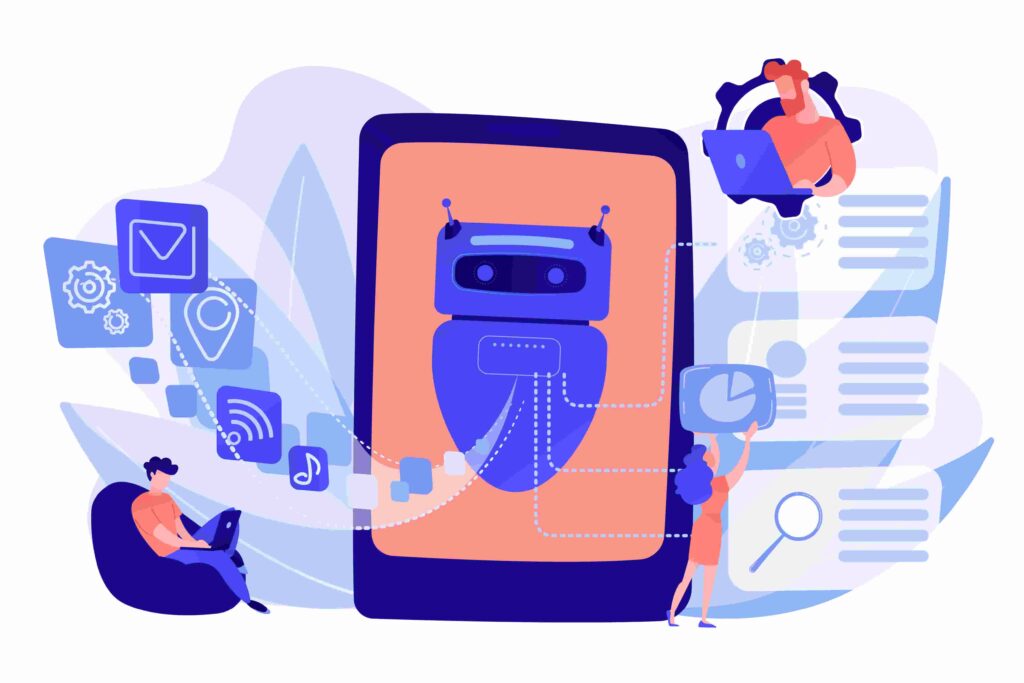Customer service is a major differentiator of a company. For this reason, proper standards and procedures must be defined to optimize customer service and promote more qualified management. With that in mind, it’s time to learn about customer service SLA and understand how it can improve your company’s internal and external communication and positively impact your customer service, marketing and sales departments.
What is an SLA?
SLA stands for service level agreement. It’s a document that outlines a commitment between a service provider and a customer or between different departments within a company, aligning the expectations and responsibilities of both parties.
It describes the details of the service to be provided and determines the standards, agreements, and goals that guide the service.
However, for an effective SLA, it’s important to review the agreement from time to time. After all, current needs can change, requiring alterations in guidelines and other aspects of the agreement.
When was SLA first adopted?
SLA was first used between the 1970s and the 1980s in order to align expectations, evaluate employee performance, and improve operational efficiency.
Over time, SLAs began to define specific standards and practices, leading to more efficient evaluation and service improvements.
Benefits of SLAs
SLAs offer a higher level of security and credibility to the parties involved, as well as many other associated benefits, as this tool can:
- optimize communication;
- increase customer satisfaction and loyalty;
- offer clear processes;
- improve team performance and productivity;
- align expectations;
- avoid rework, excess work, and undue charges;
- allow assessment of service quality through metrics.
Types of SLAs
See below the differences between each type of customer service SLA:
-
Service-based SLA
Service-focused SLA describes the services and general goals to standardize the desired level of quality and reduce bureaucracy in the case of new hires, for example.
-
Customer-based SLA
Customer-focused SLA supports a higher level of service personalization, as it considers the needs, expectations, and details of every service, requiring a new agreement model for every hire.
-
Multilevel SLA
Multilevel SLA is the most comprehensive agreement model, with each level addressing different issues, as follows:
- Corporate-level SLA: covers more generic specifications of service level management, with less frequent updates in the SLA;
- Customer-level SLA: covers customer-related issues, such as operation hours, means of communication, points of contact, among others.
- Service-level SLA: covers service-related issues, such as delivery quality standards, deadlines, and KPIs.
SLA models
Three SLA models are typically used, which vary depending on the level of specification and service details:
1. Simple SLA
In this model, a standard rules the service provision and both customer and service provider agree on such standard.
In this model, it’s important to detail the service, the conditions for service provision, and the service standard, which includes a quality indicator, periodicity, and even a penalty for non-compliance with the expected quality.
2. Non-negotiable SLA
A non-negotiable SLA is an agreement whose conditions are not negotiable, that is, it doesn’t require negotiation, with a template defined by the service provider and accepted by the customer/consumer. In this model, non-compliance with any clause, whether by the customer or the service provider, has clear penalties and can be taken to court.
3. Complex SLA
A complex SLA outlines responsibilities, rights, and penalties for both parties when hiring an IT company.
In this model, it’s important to define a deadline for every service, measures to be adopted in case of problems, deadlines to resolve non-compliances, as well as fines and penalties.
Who needs an SLA?
An SLA can be used to manage various activities in different departments. However, it is required when hiring IT service providers, such as internet providers, software developers, among other IT infrastructure services.
How to write an effective SLA document?
Now that you know what customer service SLA is and why it is important, it’s time to learn how to write a comprehensive and effective contract. Consider the suggestions below when writing an SLA document:
-
IDENTIFY CUSTOMER NEEDS
Identify customer needs and make sure they’re easy to understand. After all, an effective SLA must ensure fulfillment of customer demands.
-
DEFINE SERVICE OBJECTIVES
Explain what customer needs will be fulfilled with the service and how it will happen.
-
DESCRIBE ALL ACTIVITIES INVOLVED IN SERVICE PROVISION
Outline all activities covered in service provision to ensure an effective SLA.
-
REDUCE CONFLICTS
Talk to the customer about the concepts and expectations regarding the product or service and clear up all aspects that may generate misinterpretations.
-
ENCOURAGE COLLABORATION AND DIALOGUE
Use communication and relationships to help you solve problems. To reinforce that, hold periodic meetings, set deadlines to resolve situations contrary to the agreement, and offer other possibilities for dialogue.
-
ALIGN EXPECTATIONS
Align expectations regarding customer needs and what will be possible to provide with the product or service, ensuring the customer and the service provider reach an agreement.
-
CHOSE PERFORMANCE METRICS
Define productivity indicators, quality metrics, and KPIs related to service schedule to evaluate service quality and whether it meets the standard established in the SLA.
-
SELECT SERVICE MONITORING REPORTS
Reports are essential to guide the decision-making process. Therefore, it’s important to determine the ideal frequency of service reports and evaluations.
-
DETERMINE THE MANAGEMENT SYSTEM
Define in the SLA how demands will be managed so that customers can request new activities and report problems and the service provider can set a deadline to resolve a problem according to preset priorities.
-
SET RESPONSIBILITIES FOR EACH PARTY
Describe the responsibilities, obligations, and non-compliance penalties for both parties, informing deadlines, people in charge, means of communication, and other information that can be relevant to the operation.
-
OUTLINE SECURITY ROUTINES AND PRIVACY POLICIES
Describe security routines and privacy policies, assigning people in charge at different permission levels.
Also, create an incident management routine to minimize risks and losses and avoid legal proceedings.
-
SET OWNERSHIP RIGHTS
Include clauses describing ownership rights and a non-disclosure agreement to prevent the service provider from disclosing strategic information and the customer from disclosing a system code.
-
CONSIDER SLA REVIEWS
Consider the need to review or adjust the service and the agreement, updating information and complement it with new specifications.
DIFFERENCES BETWEEN SLA AND KPI
Many people may confuse SLA and KPI as they are both essential tools to ensure the actions are aligned with objectives and constantly monitored. However, they have very different characteristics and purposes.
An SLA is a formal agreement that outlines the expectations and commitments between a service provider and a customer, ensuring compliance with the conditions established by the service provider.
On the other hand, KPIs are indicators that measure the effectiveness of an activity, evaluating whether performance is adequate in relation to the organization’s strategic goals.
Therefore, although both are essential for effective business management, their applications and purposes are different, but both contribute to a successful business in different ways.
RELATIONSHIP BETWEEN SLA AND CUSTOMER SERVICE
A customer service SLA ensures a positive customer experience; after all, the agreement shapes the quality and effectiveness of customer service. Therefore, an SLA in customer service:
- defines specific metrics, such as response time and resolution time;
- establishes guidelines so that customer requests are properly resolved;
- maintains transparent communication, with regular updates and providing information during the service process.
Also, an SLA drives continuous improvement, encouraging managers to build lasting relationships, increasing customer satisfaction and leading to brand success and a positive brand reputation.
HOW TO TRACK AN SLA?
An SLA can be tracked in several ways to ensure goals and deadlines are met, using:
- management and service tools that monitor deadlines and performance indicators;
- regular meetings to evaluate compliance with the SLA and identify any failure;
- analysis of reports and performance indicators and results achieved in relation to predefined goals.
For effective monitoring, online systems that offer ticket management tools, such as Milvus, are the perfect option. With Milvus platform, you can optimize the IT team management, increasing efficiency and productivity.
SLA BEST PRACTICES
Here are some practices to create effective SLAs:
- Define clear and specific objectives for each metric, ensuring that everyone understands what is being measured;
- Involve both parties to promote acceptance and commitment and minimize misunderstandings;
- Set realistic and achievable targets, avoiding frustration and discouragement;
- Conduct periodic assessments of the SLA performance, making adjustments in areas that require improvement;
- Document all details of the agreement, such as goals, responsibilities, penalties, and rewards;
- Maintain proactive communication about the SLA performance, building trust and transparency.
WHAT IS CUSTOMER SERVICE SLA?
Customer service SLA is an agreement that defines the level of quality that must be achieved by the customer service team, ensuring a high quality customer experience.
This way, the document determines operational guidelines for the service team and defines KPIs to measure whether the support service meets consumer expectations and resolves their requests.
It also establishes rules to guide the actions of service agents in different situations, as well as the rights and duties of each party, deadlines that must be met, and metrics that will be applied.
Customer service SLA should consider some steps, as defined below:
- Analyze the service history and identify errors that should be eliminated.
- Understand customer’s point of view of the service quality.
- Investigate customer service of key competitors to gain insights that can be replicated.
- Outline the SLA clauses clearly.
- Define indicators to measure the service quality and assess whether the service provider is complying with the agreement.
- Select channels to interact with customers and provide the service.
- Define penalties for non-compliance with the provisions in the agreement.
Read more: What customer relationship management is and how to use it in service desk
HOW TO CALCULATE CUSTOMER SERVICE SLA?
The first step to calculate customer service SLA is to select significant metrics for the business, such as average waiting time, total service time, response time, satisfaction level, among others.
Next, set goals and objectives and, finally, monitor the results.
With this information in hand, it’s time to use the following basic formula to calculate compliance with the customer service SLA:
SLA = (number of requests resolved within the deadline ÷ total number of requests) x 100
This formula provides the percentage of requests resolved within the deadline defined in the SLA.
EXAMPLES OF SLA USES
-
Sales & Marketing SLA
One of the most common types of SLA is between Marketing and Sales departments, ensuring transparency and alignment of processes between the two teams in order to support the company’s goals.
Therefore, positive outcomes result from clear goals and aligned expectations for both teams.
-
Customer Service SLA
The quality of customer service is essential to generate customer retention and ensure the customer satisfaction. For this reason, the agreement determines KPIs to measure support quality and effectiveness, which will support the identification of opportunities for improvement, promoting a better understanding of customer needs and more efficient solutions.
-
IT SLA
An IT SLA determines customer support best practices to ensure everything is working as planned.
In this case, the agreement outlines what is expected from the IT service, such as speed of service and good use of investments allocated to the department. The agreement also establishes guidelines for the relationship between users and technicians, defines IT priorities, and determines an average ticket response time to avoid bottlenecks.
CONCLUSION
In short, an SLA is an agreement between two parties that specifies the service provided at technical, operational, and managerial levels.
It defines quality standards and KPIs to monitor customer service, which allows a concrete assessment of the service, and penalties for non-compliance with obligations.
The best way to provide good customer service is to use a comprehensive help desk tool, which allows you to configure a standard SLA for user support.
This tool prevents forgotten or inadequately prioritized tickets and generates reports that support analysis of managers and customer feedback of IT activities and efficiency.
Do you want to know how Milvus can help your company maintain the highest SLA rates? Contact our representatives and learn about the resources and functionalities that facilitate the management, analysis, and structuring of service agreements in your business.








